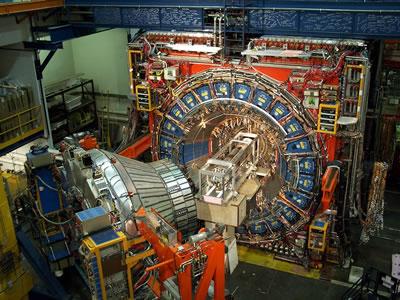Most physicists at Illinois-based Fermilab, home to the world's most powerful particle collider, share a dream. They hope against hope that the Tevatron will find the long-sought Higgs particle before the much more powerful Large Hadron Collider (LHC) at CERN — the European particle-physics laboratory outside Geneva, Switzerland — comes along in a year or so and eats their lunch. Bruce Knuteson, though, has a fear. What if the LHC finds something even more exotic than the Higgs —and the tell-tale traces of that novelty turn out to have been lurking, unrecognized, in Fermilab's data for years?
 Is there exciting data being produced at Fermilab that no one has noticed?Office of Science / U.S. Department of Energy
Is there exciting data being produced at Fermilab that no one has noticed?Office of Science / U.S. Department of EnergyIt is to rule out the chance of his worst fears coming true, among other things, that Knuteson and his colleagues at the Massachusetts Institute of Technology and Fermilab have taken a new sort of particle-hunting software to a new level. Rather than looking only at data in which a new particle is expected to be found, as the experiments at Fermilab normally do, it looks at a much broader swath of data without any preconceptions.
This approach may not be as sensitive as the more traditional, targeted searches tuned to study particular types of event. But it has the great advantage of looking everywhere, including in places that no one else has thought to look.
The first results of this 'global search' approach were presented at the PHENO 2007 meeting in Madison, Wisconsin, on 7 May. There were no new discoveries — but, Knuteson and his team insist, that's not bad news. The null results show that nothing really obvious was missed by the Collider Detector at Fermilab (CDF), one of two experiments that monitor the Tevatron's colliding streams of matter and antimatter.
The results also show that the CDF team has a good understanding of their detector and of the 'Standard Model' of forces and particles on which this sort of physics is based. And they don't rule out finding new physics in the months and years to come. "When we say new physics is just around the corner — we've now explored 25% of what's around that corner," says Knuteson.
Did you check under the carpet?
Asked why no one has done this before, Knuteson says that "the idea of looking in as many places as you can is old and obvious, but it is not what happens in practice". It was an uphill struggle convincing the collaboration running the CDF detector (of which Knuteson is himself a member) of the merits of the approach, and convincing them to release the data.
Knuteson estimates that their team has given roughly 60 internal presentations in the past year aimed at persuading the doubters. "It's unheard of. It breaks a record," comments Fermilab theorist Stephen Mrenna.
The resistance was not spread evenly: "Theorists are almost all in favour, experimentalists are almost all resistant," says Knuteson. Theorists say they are more open-minded to new ideas and are anyway anxious for any hints of where to look next. It took much longer to convince the experimentalists that the approach was even feasible.
ADVERTISEMENT
They also have different attitudes to data; theorists would welcome making public all 10,000 plots generated by the global search, the experimentalists almost certainly would not. But now most of the 600-strong CDF collaboration have been won over — as have their counterparts on DZero, the Tevatron's other detector, which is starting up similar analyses.
Knuteson's team plans to analyse the rest of CDF's archived data this summer, and to keep up the global-search approach with new data until the collider shuts down. So by 2009, they may have gone through eight times as much data as they have so far.
Although the global-search approach is perhaps most powerful when an experiment is mature and the detectors are well understood, Knuteson also sees the approach as a useful commissioning tool for the LHC. He is hoping that the Compact Muon Solenoid (CMS) experiment on the LHC will adopt a similar search strategy when they switch on next year, using the software to help debug their detectors and to check how well they understand what's going on in the new collider. "I consider myself a high-energy physics bookie," Knuteson says. "The way I view things is about maximizing payout."
Visit our physicistshuntfort.html">newsblog to read and post comments about this story.
